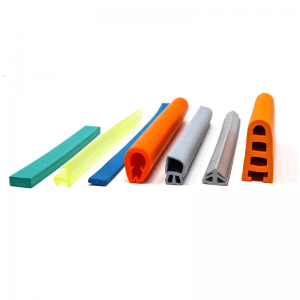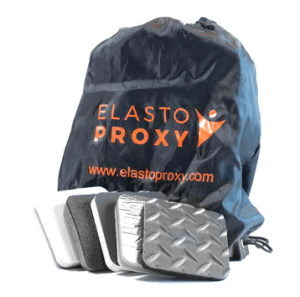The physical properties of rubber compounds are material characteristics that don’t involve a change in chemical composition. Some physical properties, such as hardness, can be observed without changing a compound’s physical state. Others, such as tear resistance, can only be observed as a compound undergoes a physical change (such as tearing).
Elasto Proxy is a fabricator and distributor that provides companies with industrial rubber products. Keep reading to learn about the physical properties of rubber compounds, or compare compounds based on material properties.
Tensile Strength
Rubber stretches, but only to a point. After that, it begins to fracture and fail. Tensile strength describes the amount of force needed to pull a rubber sample apart until it breaks. It’s measured in either pounds per square inch (psi) or kilopascals (kPa). In applications where rubber is stretched, such as seals that are used with shafts, tensile strength is critical.
Hardness
Hardness describes a rubber’s resistance to indentation. There are different ways to measure it, including the Shore A scale. Durometer is the unit of measure, and smaller durometers indicate softer materials. Rubber’s hardness can also be measured in terms of the international rubber hardness degree (IRHD) on a scale from 0 (softest) to 100 (hardest). Note that each type of compound comes in a range of hardnesses.
Specific Gravity
Specific gravity is the ratio of the weight of a material to the weight of an equal volume of water at a specified temperature. It’s a dimensionless number, but rubber with a higher specific gravity is heavier. That’s an important consideration with applications such as vehicle lightweighting, or if you need a seal to withstand a heavy load.
Tear Resistance
Tear resistance or tear strength describes a rubber’s resistance to the growth of a nick or cut under tension. This physical property includes the force required to initiate a tear and the force required to propagate it. If your seal will come into contact with rough metal edges or sharp objects, tear strength is especially important. Examples include the edge trim used with stainless steel work tables.
Abrasion Resistance
Abrasion resistance describes a rubber’s resistance to rubbing or scraping. It’s an important property because if too much rubber is removed, a seal might begin to leak. Rubber with high abrasion resistance is needed for pump seals that handle slurries, mixtures of denser solids suspended in liquids. Yet even door seals require enough abrasion resistance to avoid wear.
Rebound (Cold and Hot)
Rebound or resilience refers to a rubber’s ability to regain its original size and shape after it’s temporarily deformed. This physical property is especially important in dynamic seals where you need a barrier between a moving surface and a stationary one. For example, a door seal is temporarily deformed when a door (the moving surface) is closed and deforms a seal that’s attached to a stationary door frame. Rebound is related to temperature, so consider thermal properties as well.
Compression Set
Compression set refers to the permanent deformation that occurs when a material is compressed under a specific load for a specific time and at a specific temperature. With EPDM rubber, for example, a compression set of 22 hours at 125° C results in a compression set of 25%. Relative to other commonly used elastomers, that’s considered to be Fair rather than Good.
Gas Permeability
Gas permeability describes the rate at which gas molecules such as air pass through a rubber compound. Most rubber has low gas permeability, but some applications require exceptional performance. Examples include fuel seals on low-emissions vehicles and medical seals that are subjected to autoclaving, a sterilization process that uses high heat and pressure.
Water Absorption
Water absorption refers to a rubber’s ability to absorb water from its environment. Because rubber is porous, some amount of water absorption is normal. Compounds where the water absorption is described as Very Good or Excellent absorb very little water, an important consideration for environmental sealing. This is one of the reasons that EPDM is often used in weather seals.
Oxidation
Oxidation adds oxygen to a substance. With rubber, that’s a problem because the added oxygen reacts with and removes the sulfur that was used in vulcanization to build molecular chains. Without this sulfur, the rubber becomes weaker and less elastic. Rubber materials with Very Good or Excellent oxidation are less likely to experience these problems.
Ozone
Ozone is a colorless gas with powerful oxidizing properties. It’s produced from oxygen either by electrical discharges or ultraviolet (UV) light. With rubber, ozone breaks molecular bonds and can cause a form of cracking called dry rot. Rubber with Very Good or Excellent ozone resistance is recommended for outdoor seals exposed to sunlight, a form of UV light, and electrical equipment such as motors.
Sunlight Aging
Sunlight ages destroys rubber’s molecular bonds and causes a loss of strength, elasticity, and flexibility. As this damage increases over time, it can lead to seal failure. Sunlight aging describes how well a rubber resists the sun’s UV rays. Poor sunlight aging may be acceptable for indoor applications, but seals that are used outdoors need to resist photodegradation.
Find the Physical Properties for Rubber Materials
For more information about selecting the right rubber for industrial seals, contact Elasto Proxy.










